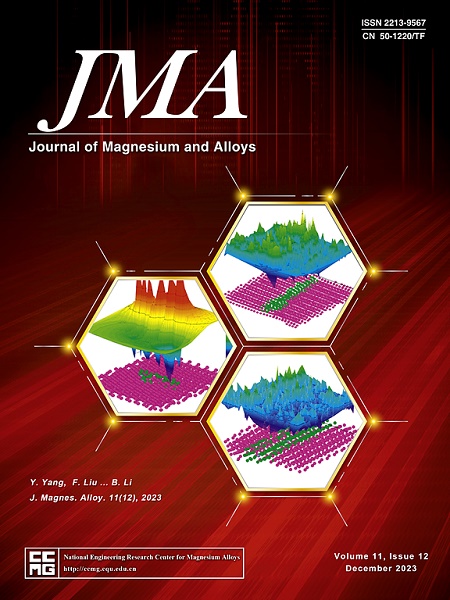Effect of magnesium fluoride catalysis on the vacuum reducing properties of magnesium oxide
IF 13.8
1区 材料科学
Q1 METALLURGY & METALLURGICAL ENGINEERING
引用次数: 0
Abstract
Low reduction efficiency is a critical issue that limits the advancement of the magnesium vacuum carbothermal reduction smelting process. This investigation introduces a novel magnesium smelting process that substitutes magnesium fluoride (MgF₂) for calcium fluoride (CaF₂) as a catalyst in the vacuum carbothermal reduction of magnesium. The viability and optimal operating conditions of the new method were assessed through thermodynamic calculations of Gibbs free energy in the MgO C-MgF₂ system. Additionally, the catalytic effects of MgF₂ on the reduction of MgO were examined under different holding times in vacuum conditions. Analytical results indicated a significant improvement in the reduction efficiency of MgO upon the incorporation of MgF₂. MgF₂ serves a catalytic function in the reduction process, When F⁻ acts, it elevates the relative concentration of Mg in the reduction system and promotes the reduction reaction. Improvements in reduction efficiency are observed as the holding period duration increases and with higher concentrations of MgF₂. However, the improvement in reduction efficiency tends to plateau when the concentration exceeds 7 %. The resulting magnesium condensate exhibits a robust crystalline structure, with a purity of 79.39 %. The crystallization outcomes are influenced by the degree of reverse reactions. Compared to CaF₂, MgF₂ offers significant economic, environmental, and catalytic advantages. This process supports the goals of sustainable, green development and aligns with clean production standards in the magnesium metallurgy sector.
C-MgF₂ system. Additionally, the catalytic effects of MgF₂ on the reduction of MgO were examined under different holding times in vacuum conditions. Analytical results indicated a significant improvement in the reduction efficiency of MgO upon the incorporation of MgF₂. MgF₂ serves a catalytic function in the reduction process, When F⁻ acts, it elevates the relative concentration of Mg in the reduction system and promotes the reduction reaction. Improvements in reduction efficiency are observed as the holding period duration increases and with higher concentrations of MgF₂. However, the improvement in reduction efficiency tends to plateau when the concentration exceeds 7 %. The resulting magnesium condensate exhibits a robust crystalline structure, with a purity of 79.39 %. The crystallization outcomes are influenced by the degree of reverse reactions. Compared to CaF₂, MgF₂ offers significant economic, environmental, and catalytic advantages. This process supports the goals of sustainable, green development and aligns with clean production standards in the magnesium metallurgy sector.

氟化镁催化对氧化镁真空还原性能的影响
还原效率低是制约镁真空碳热还原冶炼工艺发展的关键问题。介绍了一种以氟化镁(MgF₂)代替氟化钙(CaF₂)作为镁的真空碳热还原催化剂的镁冶炼新工艺。通过MgOC-MgF 2体系的吉布斯自由能热力学计算,评价了新方法的可行性和最佳操作条件。在真空条件下,考察了不同保温时间下MgF₂对MgO还原的催化作用。分析结果表明,MgF - 2的加入显著提高了MgO的还原效率。MgF₂在还原过程中起催化作用,当F⁻起作用时,会提高还原体系中Mg的相对浓度,促进还原反应的发生。随着保温时间的延长和MgF 2浓度的增加,还原效率也有所提高。当浓度超过7%时,还原效率的提高趋于平稳。所制得的镁凝结物具有坚固的结晶结构,纯度为79.39%。结晶结果受反反应程度的影响。与CaF₂相比,MgF₂具有显著的经济、环境和催化优势。这一过程支持可持续、绿色发展的目标,并与镁冶金行业的清洁生产标准保持一致。
本文章由计算机程序翻译,如有差异,请以英文原文为准。
求助全文
约1分钟内获得全文
求助全文
来源期刊

Journal of Magnesium and Alloys
Engineering-Mechanics of Materials
CiteScore
20.20
自引率
14.80%
发文量
52
审稿时长
59 days
期刊介绍:
The Journal of Magnesium and Alloys serves as a global platform for both theoretical and experimental studies in magnesium science and engineering. It welcomes submissions investigating various scientific and engineering factors impacting the metallurgy, processing, microstructure, properties, and applications of magnesium and alloys. The journal covers all aspects of magnesium and alloy research, including raw materials, alloy casting, extrusion and deformation, corrosion and surface treatment, joining and machining, simulation and modeling, microstructure evolution and mechanical properties, new alloy development, magnesium-based composites, bio-materials and energy materials, applications, and recycling.
 求助内容:
求助内容: 应助结果提醒方式:
应助结果提醒方式:


